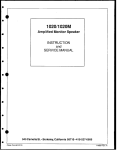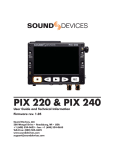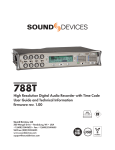Download Dixon Systems NM-250 MKII Owner`s manual
Transcript
Dixon Systems Model NM-250 MKII Owner's Manual Dixon Systems NM-250 MKII Introduction The NM-250 MKII newsroom mixer is designed for newsroom work-stations and contains almost all the features of a full stereo broadcast console in a two rack-space unit. The NM-250 MKII retains all the features of the original NM-250 but adds a number of features and improvements. The NM-250 MKII improvements include new microphone input stages that can be easily changed to line level with no component changes. A simple jumper selects either ‘mic’ or ‘line’. Tally LEDs have been added to the two talk back push-buttons to indicate who is calling. Both a ‘Start’ and ‘Stop’ pulse are now provided for the telephone input and the computer input. This makes interfacing with a wider variety of hybrids much easier. Overall, the NM-250 MKII features two greatly improved microphone/line inputs with phantom power for condenser microphones, a mix-minus bus for feeding a telephone hybrid, an input for the hybrid return, an interface for the computer sound card, a miniature jack front panel input for cassette/DAT machines, and two balanced +4 line inputs. In addition, the unit features a cue system as well as a talk back system with two sends and returns. It contains a built in headphone amplifier and an output for a stereo monitor amplifier. (See information about Dixon Systems’ RM-35.) A front panel control permits the monitoring to be switched between the output of the mixer and an external input, usually an off-air feed. To achieve the best performance possible, low noise 1% metal-film resistors are used throughout the audio path. A toroidal transformer is used in the power supply to ensure quiet, cool and clean operation. Dixon Systems NM-250 MKII Unpacking and Inspection Carefully examine the contents of the shipping carton for any sign of physical damage which could have occurred in transit. IF DAMAGE IS EVIDENT, DO NOT DESTROY ANY OF THE PACKING MATERIAL OR CARTON. IMMEDIATELY NOTIFY THE CARRIER OF A POSSIBLE CLAIM FOR DAMAGE. SHIPPING DAMAGE CLAIMS MUST BE MADE BY THE CONSIGNEE. Environmental Considerations The NM-250 MKII will operate satisfactorily over a wide range of ambient temperatures. If installed in an area with high heat producing equipment, adequate ventilation is necessary to prolong the life of components. Wiring for local power line Conditions The units have been pre-wired at the factory for 110 VAC operation, as indicated on the shipping cartons. To comply with existing electrical codes, each unit is supplied with a three-wire AC power cord with the ground pin connected to the chassis. Never replace the fuse with anything other than a 1/3 amp Slo-Blo fuse. General The NM-250 MKII is ruggedly constructed and should provide years of trouble-free use with normal care. Occasional cleaning with a damp cloth is recommended for the front panel, and should dust collect inside the unit, disconnect it from AC power, remove the top cover, and use a small vacuum to gather up the dirt. Be careful not to dislodge any of the internal connectors. No other special preventive maintenance is required. All parts are conservatively rated for their application, and all ICs are socketed for ease of replacement. Workmanship meets the rigid standards professional users expect. Dixon Systems NM-250 MKII Performance Specification Line Inputs Balanced Inputs Source impedance Input impedance Input level Maximum input level Unbalanced Inputs Source impedance Input impedance Input level Distortion & T.H.D. Noise Intermod. (4:1) Frequency Response 600 Ohms 40 kOhms Nominal +4dBm +28 dBm < 2 kOhm 20 kOhms Nominal -10 dBu < .01% 20-20 kHz Typical: .005% ( +4 in/ +4 out) Better than -80dB (Ref. 0 dBu) < .005% (Typical: .003%) Better than +/- .5 dB 20 Hz-20 kHz Microphone Inputs Source impedance Input type Input level Distortion & T.H.D. Frequency Response Master Outputs Output impedance Output level Maximum Output level Cross Talk Other Outputs Unbalanced Output (RCAs) Monitor output Talkback Outputs Headphone Amp 150 Ohms Active Balanced Nominal -56 dBu < .01% @ G=100 (Full range) Better than +/- .5 dB 30 Hz-15 kHz 60 Ohms Active balanced + 4 dBm (as shipped) Adjustable +22 dBm Better than -60 dB Nominal -10 dBu Rear panel Adjustable Active Balanced +4 db Front panel gain adjust Active balanced Nominal +4 dBm (Adjustable) 350 mw into 8 Ohms Front panel gain adjust. Front panel jack Dixon Systems NM-250 MKII Simplified Block Diagram NM-250 MKII Dixon Systems NM-250 MKII Microphone Inputs The NM-250 MKII has three low-Z microphone inputs. They are identical, except that Mic 1 is also used as part of the Talkback send system and the third input is normally configured as a line input return from the telephone hybrid. Input connectors are XLR type and are located on the rear panel. Inputs one and two both have phantom power to allow the use of high quality condenser microphones if desired. Gain is fixed, but most microphones used in today’s facilities should have adequate output for the mixer. A simple computer style jumper located on the board near the input IC determines if the stage works at mic or line level. Either microphone can mute the monitor output. The mute function is programmed via jumpers located on the rear of the circuit board mounted on the front panel. When shipped, both microphones are set to mute. Microphone 1 should be used by the operator. The second microphone can be used in a booth or studio if desired, and has a Cue switch to permit monitoring. Dixon Systems NM-250 MKII Talkback Send System The talkback system in the NM-250 MKII allows communication to and from two remote locations. A typical situation might be between the newsroom, a studio or booth, and the control room. Talkback # 1 has been designed to permit the use of a TCC or single pair for both send and receive. This is most often used when the NM-250 MKII is acting as a remote mixer. New in the ‘250 MKII are tally lights that indicate who is calling. These are controlled by simple ground starts located on the rear panel. Audio from the first microphone pre-amp is sent to the talkback-send op-amp where additional gain is added. Output level is a nominal +4 dBm (balanced) and gain is adjusted via the trim pot on the main PC board. This trim pot sets the level for both send outputs. When a talkback button on the front panel is pressed, it activates one of the two talkback relays and audio is fed to the rear panel connector. At the same time, the monitor mute relay is activated and a contact closure is provided for signalling the talkback-receive station. Dixon Systems NM-250 MKII Talkback Receive System The NM-250 MKII has two talkback receive inputs. When a signal is sent to either of these inputs, it is applied to one half of a 5532 op-amp and the receive level is adjusted via one of two trim pots located on the main PC board. Nominal receive level is +4 dBm (balanced). The signal is then sent to the monitor summing-amplifier where it is added to one side of the monitor system. A ground start is available on the rear connectors for ‘tally’ for each talkback input as well as a ground start for the DIM function. Simply grounding the appropriate pin is all that’s required. As indicated earlier, talkback # 1 can be used with a single twisted pair, (sometimes referred to as a TCC) most often when the NM-250 MKII is used as a remote mixer. Dixon Systems NM-250 MKII Telephone Input The output of the telephone hybrid normally goes to the third input of the NM-250 MKII. It is identical to the microphone inputs, except that the ‘mic/line’ jumper is not installed. Nominal input level is 0 dBu. The NM-250 MKII also provides a contact closure to ground (on the remote control connectors) whenever the telephone channel is turned on, eliminating the need to activate more than one switch when an interview is being conducted. As well, this channel can be configured to mute the monitor output of the mixer, should this be required. New in the ‘MKII are ‘on’ and ‘off’ open collectors to control the hybrid. These provide a pulse to ground of approximately 100ms. Some customers are using the NM-250 MKII as a remote mixer. If desired, and a phone channel is not required, this input can also be and used as a third microphone input. It should be noted that the two 6K81 resistors for phantom power are not installed in this channel, and that the 20K resistor feeding the mix-minus bus has also been removed, preventing feedback when used with a hybrid. Dixon Systems NM-250 MKII Computer Interface The NM-250 MKII interfaces easily with computer sound cards. Usually, some kind of unbalanced to balanced unit (such as Dixon Systems “LineMatcher” model LM100B) is required to connect a sound card to professional equipment. This is not necessary with the NM-250 MKII. There are four RCA-type connectors on the rear panel of the unit, two as inputs coming from the sound card and two which send audio to the sound card. They are clearly marked. As seen in the schematic below, the output from the sound card is applied to a differential input op-amp, a 5532. Nominal input level is -10 dB. The level coming from the sound card should be set so that the control on the front panel is between one and two o’clock. This will ensure adequate headroom. The NM-250 MKII now provides a pulse to ground for both ‘start’ and ‘stop’. These can be used to start and stop the computer playback. Pulse duration is about 100 ms. Each time the channel is turned on or off it generates a pulse. The connections are made via the connectors on the rear panel. The output to the sound card comes directly from the output stage of the mixer. For more information, see the output section of this manual. Dixon Systems NM-250 MKII Front Panel Input Jack Another useful feature of the NM-250 MKII is its front panel input jack. This is a miniature tip/ring/sleeve jack, common to many cassette and DAT machines. It allows the user to quickly dub an interview, etc. to the computer’s hard drive so that it can be edited in the computer. Please note that this is a stereo input with the left channel on the tip, the right channel on the ring, and of course, ground on the sleeve. Be sure you’re using the right plug! While the location of the jack may seem a bit awkward, it’s felt that in most circumstances, the cassette/DAT will simply be connected, the level set, and the NM-250 MKII left alone until the dub has been made. As seen in the schematic, the circuitry of this section is almost identical to that of the computer sound card input. There is no ‘channel on’ switch for this input. Dixon Systems NM-250 MKII Line Level Inputs There are two active balanced +4 dBm line level inputs to the NM-250 MKII. Both are identical. Connections are made via XLR type connectors located on the rear panel of the mixer. These inputs would normally be connected to the output of a simple switch bank, or in more elaborate installations, a routing switcher. Again, as seen in the schematic below, the circuitry is identical to the other line inputs, except that values have been adjusted to accommodate a +4 dBm signal level. Dixon Systems NM-250 MKII Master Output Amplifiers Again, a 5532 is employed as a summing amplifier, this time with one half of the opamp connected to the left program bus, the other half connected to the right bus. The outputs of the summing amplifiers are connected to the master output gain control trimpots located on the main PC board. Two more 5532 op-amps are configured as active balanced line drivers, one for the left channel and the second for the right channel. A portion of the output signal of each channel is fed to the sound card trim-pots, which are adjusted from the rear panel To adjust the output level, feed a 0 dBm tone @ 1 kHz into the telephone input and adjust the front panel gain control for this channel so that it’s set to between one and two o’clock. Using a good quality meter, adjust the master left and right output trim-pots so that the output of the mixer reads + 4 dBm (at the output connector) on both channels. Move the meter to the sound card RCA jacks and adjust the sound card trimpots for an output level of -10 dB. Dixon Systems NM-250 MKII Summing Amplifiers All summing amplifiers in the NM-250 MKII are standard current summing devices. As seen in the schematic below, signals from the cue summing bus are applied to one half of a 5532 op-amp. Signals from the mix-minus bus are applied to the other half of this device. The summed currents are then fed to the monitor summing amplifier, and the mixminus output amplifiers respectively. The level of the mix-minus output amplifier may be adjusted via the trim-pot located on the main PC board. It’s nominal output level is +4 dBm. The mix-minus output amplifier is also a 5532 op-amp configured as an activebalanced line driver. Dixon Systems NM-250 MKII Monitor System The monitor system in the NM-250 MKII makes this mixer extremely versatile. It contains a built in headphone amplifier, a line driver for the RM-35 (or other) stereo monitor amplifier, a cue system, talkback returns, and an external input for an off-air feed. Cue and talkback are routed to the right side of the headphone and monitor outputs whenever a cue button is pressed, or an external command from the talkback system is received. As well, a front panel switch permits monitoring of either the mixer’s output or an off-air feed. A dim resistor may be installed to permit a small amount of right channel information to be mixed with cue/talkback if desired. A front panel LED illuminates whenever a cue button is pressed or a talkback is activated. Switching is accomplished with miniature 24V relays. As seen in the schematic below, signals from either the mixer’s output amplifiers or the off-air inputs are sent to the monitor summing amplifier. The Dim relay suppresses the signal of the right channel whenever a cue button is pressed. Dixon Systems NM-250 MKII Metering The NM-250 MKII uses the LM3916N-1 monolithic integrated circuit to provide an electronic version of the VU meter. The metering circuitry is on both the main PC board and the PC board which mounts behind the front panel. As seen in the schematic below, a 5532 is employed as buffers between the main output amplifiers and the metering circuitry. Drive for the meters is controlled by the two trim-pots located on the main PC board. The second 5532 op-amp is configured as precision half-wave rectifiers. The timing of this circuit provides an average reading meter. When shipped, the unit is set so that 0 VU = +4 dBm. Dixon Systems NM-250 MKII Monitor Outputs The NM-250 MKII has two monitoring outputs. A stereo headphone jack is located on the front panel and a muted output for driving a power amplifier is located on the rear panel. Relay contacts for an external mute are also provided on the rear panel. N.B. If the mute relay is used to control a studio ‘on-air’ light, do not attempt to use 110 VAC with these contacts. We recommend the use of a solid state zero cross relay with the NM-250 MKII controlling a low DC voltage to operate the solid state relay. Dixon Systems NM-250 MKII Power Supply The NM-250 MKII requires an electrical mains supply of 110 V AC 60 Hz, preferably from isolated sources. A three-wire AC cord is used with the third wire connected to the chassis and ground. This linear supply employs a toroidal transformer, ensuring quiet, cool, and clean operation. Be sure there is adequate space left above the top cover ventilation slots to ensure proper airflow. Voltages supplied are +/- 15 volts DC for all audio circuitry, +24 volts DC for all logic functions, and +48 volts DC for phantom power. Dixon Systems NM-250 MKII Logic and Control All signal switching in the NM-250 MKII is accomplished using miniature 24 VDC relays. Each time a microphone is turned on, it activates the Mic relay (which delivers audio to the summing bus), illuminates the ‘channel on’ LED, and, if the mute jumper is installed, activates the mute relay. The telephone-channel relay also provides the contact closure to ground at the remote connector. In addition, there are ‘start’ and ‘stop’ pulses ( to ground through open collectors) available for both the telephone and computer channels. These pulses are approximately 100ms in duration. Pulse duration is determined by the 6.8 ufd capacitor and the 100k resistor. Tally lights for the talkback switches are simple ground starts. Dixon Systems NM-250 MKII Circuit Locations 1} 2) 3) 4) 5) 6) 7) 8) 9) 10) 11) 12) 13) 14) 15) 16) 17) 18) 19) Talkback send Talkback receive Off-air input Mix-minus send Monitor output stage Master output stage Master summing amp Monitor summing amp Power supply Headphone amp Cue/Mix-minus summing amp Mic. 1 input Mic. 2 input Telephone input Computer input Front panel input Line one input Line two input Meter amp Main PC Board Dixon Systems NM-250 MKII Rear Panel Connections All input and output connections are made at the rear of the unit with the exception of the front panel input, designed for cassette or DAT input, and the headphone jack. The rear panel is silk-screened and inputs/outputs are identified. The remote control pin-out is as indicated below. Pin 1 Pin 2 Pin 3 Pin 4 Pin 5 Pin 6 Pin 7 Pin 8 Pin 9 Pin10 Pin11 Pin12 Ground Phone Contact Closure Ground Start T.B. Dim Mute Relay Mute Relay T.B. Tally 2 T.B. Tally 1 Ground Phone Open Collector ‘On’ Phone Open Collector ‘Off’ Computer Open Collector ‘On’ Computer Open Collector ‘Off’ Dixon Systems Notes: NM-250 MKII Dixon Systems 580 Danforth Road Toronto, Ontario, Canada M1K 1E3 www.dixonsystems.com e-mail: [email protected]





























